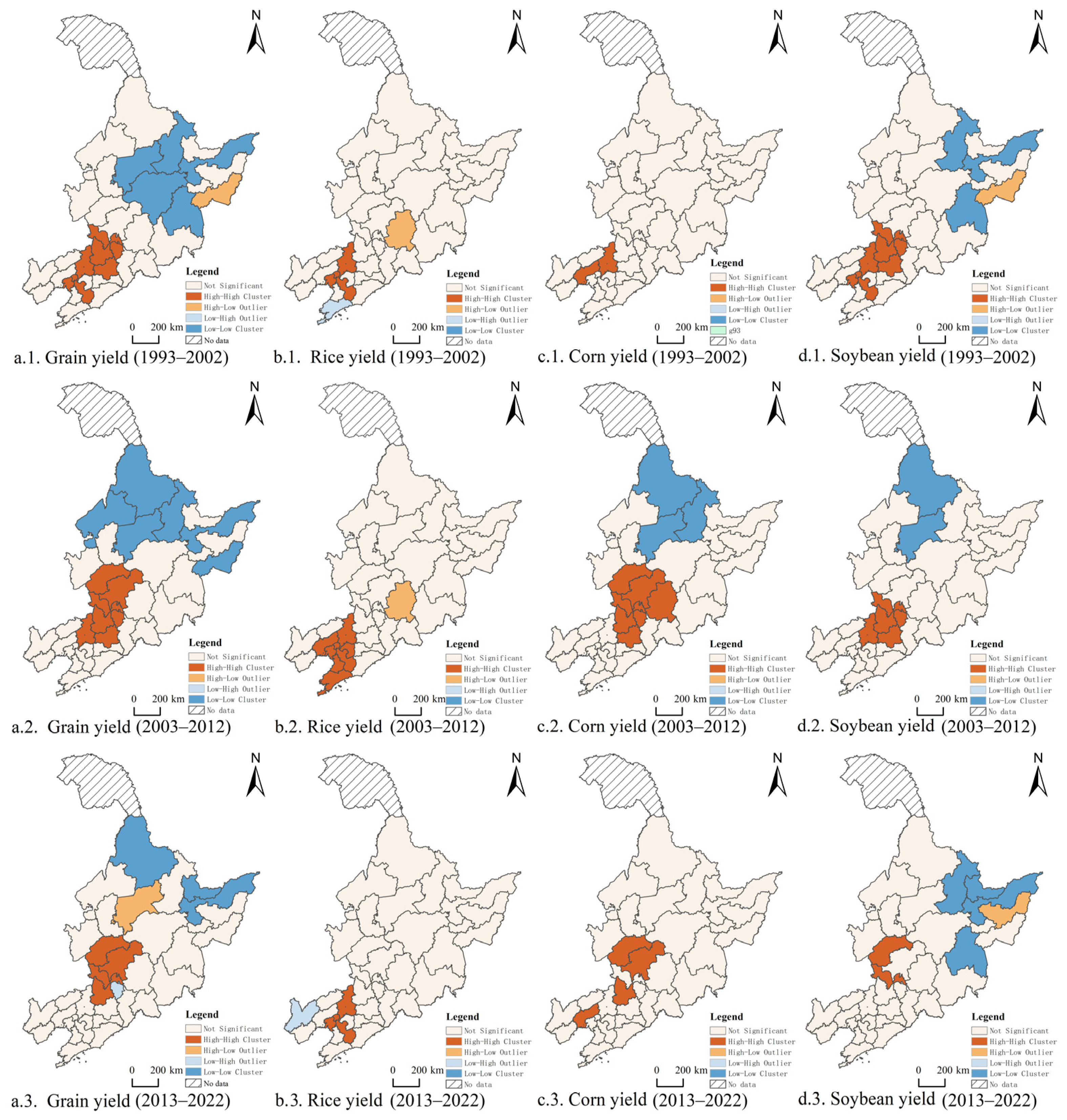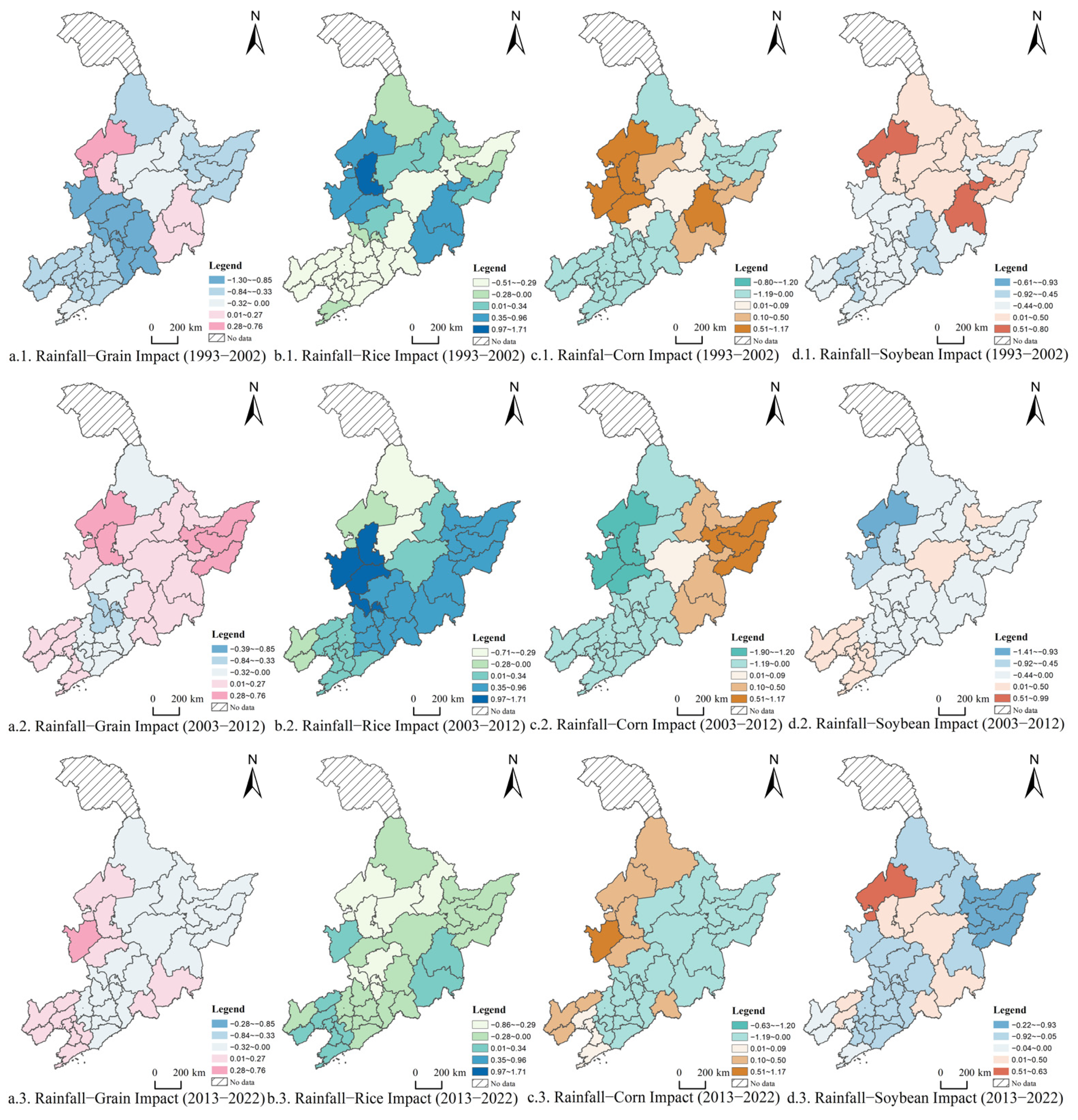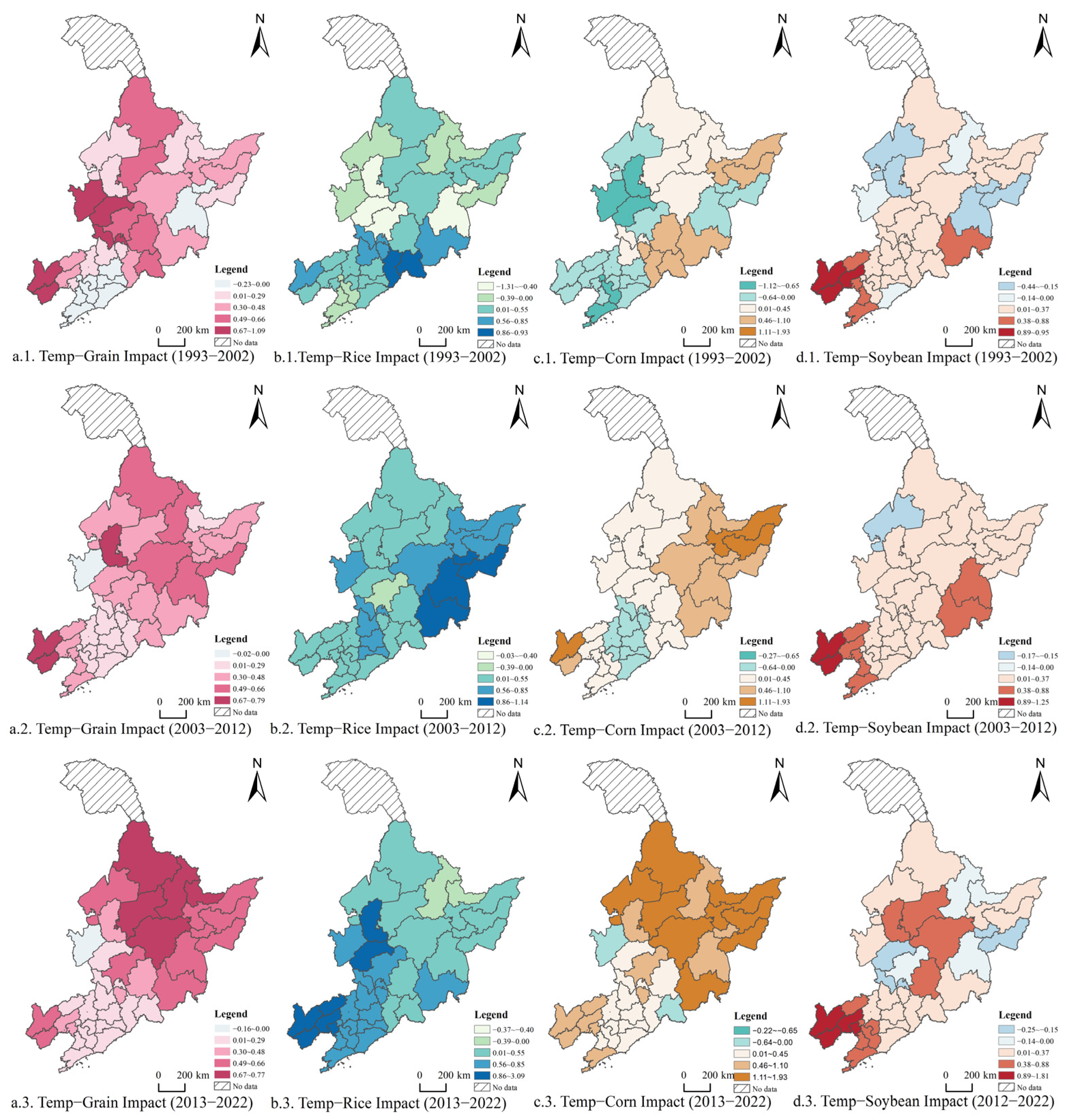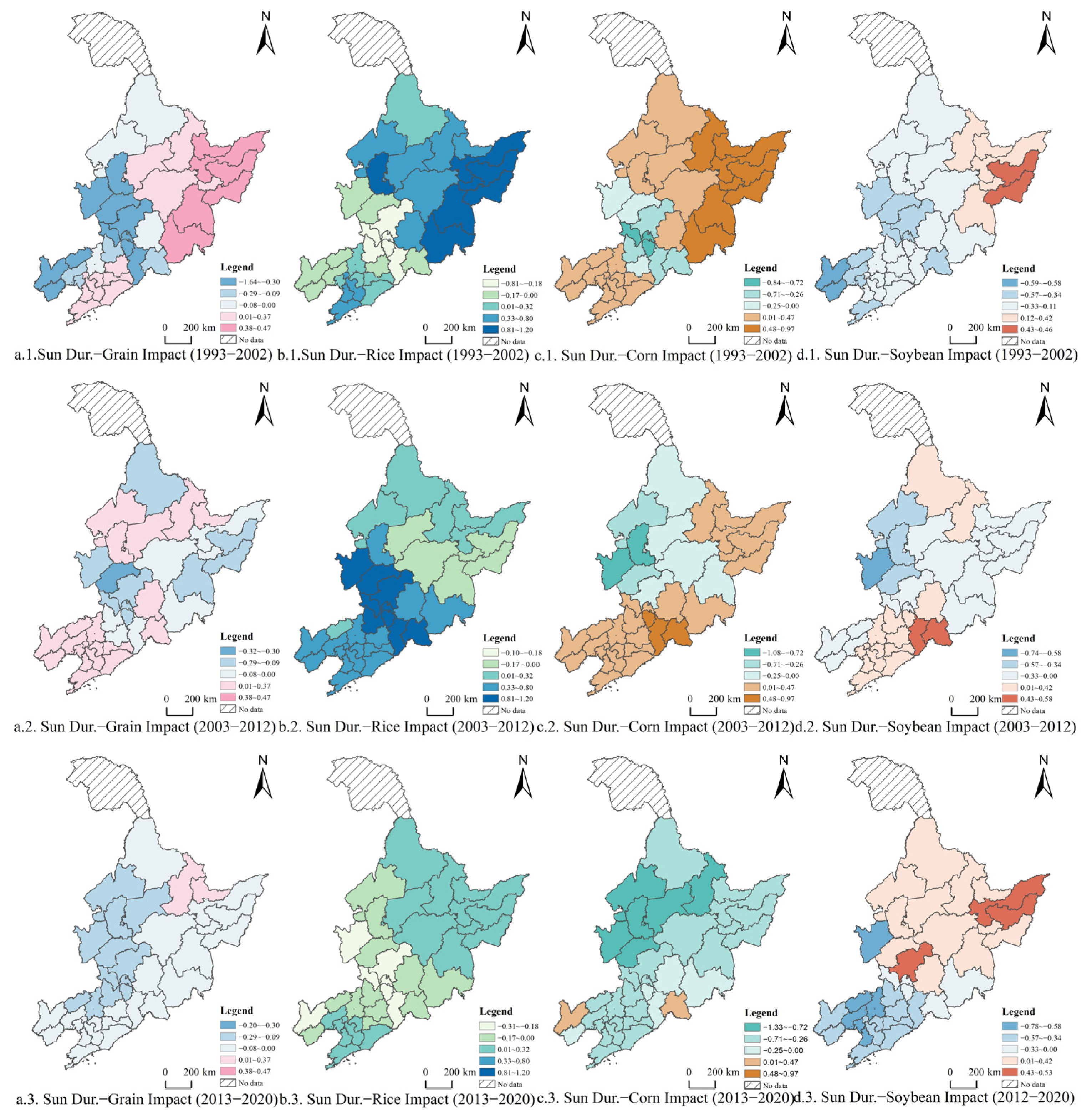Spatiotemporal Variations in Grain Yields and Their Responses to Climatic Factors in Northeast China During 1993–2022
Abstract
1. Introduction
2. Materials and Methods
2.1. Study Area
2.2. Framework
2.3. Methods
2.3.1. Methods of Trend Analysis
2.3.2. The Analysis Method of Spatial Pattern of Major Food Crop Yields in NEC
2.3.3. GTWR Model for Associating Grain Yield with Climatic Factors in NEC
3. Results
3.1. Temporal and Spatial Variations in Major Grain Crop Yields in NEC
3.2. Spatiotemporal Variations in Climatic Variables in NEC
3.3. Spatial Patterns of Major Grain Crop Yields in NEC
3.4. The Response of Grain Yield to Climate Change in NEC
3.4.1. Spatiotemporal Effects of Rainfall
3.4.2. Spatiotemporal Effects of Temperature
3.4.3. Spatiotemporal Effects of Sunshine Duration
4. Discussion
4.1. Spatiotemporal Pattern Characteristics of Grain Yield
4.2. Research on Spatiotemporal Heterogeneity of Climatic Driving Factors
4.2.1. Spatiotemporal Heterogeneity Effects of Rainfall
4.2.2. Spatiotemporal Heterogeneity of Temperature
4.2.3. Spatiotemporal Heterogeneity of Solar Radiation Duration
4.3. Policy Recommendations
4.4. Limitations and Future Prospects
5. Conclusions
Author Contributions
Funding
Data Availability Statement
Conflicts of Interest
Abbreviations
| OLS | Ordinary Least Squares |
| NEC | Northeast China |
| GTWR | Geographically and Temporally Weighted Regression |
| CMDS | China Meteorological Data Sharing Service System |
| MK | Mann–Kendall |
| VIF | Variance Inflation Factor |
References
- Nzali, C.T.; Abdelbaki, C.; Kumar, N. Assessing the Effects of Climate Variability on Maize Yield in the Municipality of Dschang-Cameroon. Land 2024, 13, 1360. [Google Scholar] [CrossRef]
- Muñoz, I.; Schmidt, J.; Weidema, B.P. The indirect global warming potential of methane oxidation in the IPCC’s sixth assessment report. Environ. Res. Lett. 2024, 19, 121002. [Google Scholar] [CrossRef]
- Fu, J.; Jian, Y.; Wang, X.; Li, L.; Ciais, P.; Zscheischler, J.; Wang, Y.; Tang, Y.; Müller, C.; Webber, H.; et al. Extreme rainfall reduces one-twelfth of China’s rice yield over the last two decades. Nat. Food 2023, 4, 416–426. [Google Scholar] [CrossRef] [PubMed]
- Wang, B.; Li, L.; Feng, P.; Chen, C.; Luo, J.-J.; Taschetto, A.S.; Harrison, M.T.; Liu, K.; Liu, D.L.; Yu, Q.; et al. Probabilistic analysis of drought impact on wheat yield and climate change implications. Weather Clim. Extrem. 2024, 45, 100708. [Google Scholar] [CrossRef]
- Heilemann, J.; Klassert, C.; Samaniego, L.; Thober, S.; Marx, A.; Boeing, F.; Klauer, B.; Gawel, E. Projecting impacts of extreme weather events on crop yields using LASSO regression. Weather Clim. Extrem. 2024, 46, 100738. [Google Scholar] [CrossRef]
- Rawat, M.; Sharda, V.; Lin, X.; Roozeboom, K. Climate Change Impacts on Rainfed Maize Yields in Kansas: Statistical vs. Process-Based Models. Agronomy 2023, 13, 2571. [Google Scholar] [CrossRef]
- He, Q.; Zhou, G.; Liu, J. Progress in Studies of Climatic Suitability of Crop Quality and Resistance Mechanisms in the Context of Climate Warming. Agronomy 2022, 12, 3183. [Google Scholar] [CrossRef]
- Asseng, S.; Cammarano, D.; Basso, B.; Chung, U.; Alderman, P.D.; Sonder, K.; Reynolds, M.; Lobell, D.B. Hot spots of wheat yield decline with rising temperatures. Glob. Change Biol. 2017, 23, 2464–2472. [Google Scholar] [CrossRef]
- Feng, X.; Tian, H.; Cong, J.; Zhao, C. A method review of the climate change impact on crop yield. Front. For. Glob. Change 2023, 6, 1198186. [Google Scholar] [CrossRef]
- Yan, Z.; Xu, Y.; Chu, J.; Guillaume, T.; Bragazza, L.; Li, H.; Shen, Y.; Yang, Y.; Zeng, Z.; Zang, H. Long-term diversified cropping promotes wheat yield and sustainability across contrasting climates: Evidence from China and Switzerland. Field Crop. Res. 2025, 322, 109764. [Google Scholar] [CrossRef]
- Drebenstedt, I.; Marhan, S.; Poll, C.; Kandeler, E.; Högy, P. Annual cumulative ambient precipitation determines the effects of climate change on biomass and yield of three important field crops. Field Crop. Res. 2023, 290, 108766. [Google Scholar] [CrossRef]
- Zhuang, H.; Zhang, Z.; Han, J.; Cheng, F.; Li, S.; Wu, H.; Mei, Q.; Song, J.; Wu, X.; Zhang, Z.; et al. Stagnating rice yields in China need to be overcome by cultivars and management improvements. Agric. Syst. 2024, 221, 104134. [Google Scholar] [CrossRef]
- Karunaratne, A.S.; Chaogejilatu; Iizumi, T. A climate impact attribution of historical rice yields in Sri Lanka using three crop models. Sci. Rep. 2025, 15, 15360. [Google Scholar] [CrossRef]
- Qin, M.; Zheng, E.; Hou, D.; Meng, X.; Meng, F.; Gao, Y.; Chen, P.; Qi, Z.; Xu, T. Response of Wheat, Maize, and Rice to Changes in Temperature, Precipitation, CO2 Concentration, and Uncertainty Based on Crop Simulation Approaches. Plants 2023, 12, 2709. [Google Scholar] [CrossRef] [PubMed]
- Noia, R.D., Jr.; Olivier, L.; Wallach, D.; Mullens, E.; Fraisse, C.W.; Asseng, S. A simple procedure for a national wheat yield forecast. Eur. J. Agron. 2023, 148, 126868. [Google Scholar] [CrossRef]
- Jägermeyr, J.; Müller, C.; Ruane, A.C.; Elliott, J.; Balkovic, J.; Castillo, O.; Faye, B.; Foster, I.; Folberth, C.; Franke, J.A.; et al. Climate impacts on global agriculture emerge earlier in new generation of climate and crop models. Nat. Food 2021, 2, 873–885. [Google Scholar] [CrossRef] [PubMed]
- Hu, T.; Zhang, X.; Khanal, S.; Wilson, R.; Leng, G.; Toman, E.M.; Wang, X.; Li, Y.; Zhao, K. Climate change impacts on crop yields: A review of empirical findings, statistical crop models, and machine learning methods. Environ. Model. Softw. 2024, 179, 106119. [Google Scholar] [CrossRef]
- Villa-Falfán, C.; Valdés-Rodríguez, O.A.; Vázquez-Aguirre, J.L.; Salas-Martínez, F. Climate Indices and Their Impact on Maize Yield in Veracruz, Mexico. Atmosphere 2023, 14, 778. [Google Scholar] [CrossRef]
- Lesk, C.; Rowhani, P.; Ramankutty, N. Influence of extreme weather disasters on global crop production. Nature 2016, 529, 84–87. [Google Scholar] [CrossRef]
- Liu, Y.; Fan, Y.; Yue, J.; Jin, X.; Ma, Y.; Chen, R.; Bian, M.; Yang, G.; Feng, H. A model suitable for estimating above-ground biomass of potatoes at different regional levels. Comput. Electron. Agric. 2024, 222, 109081. [Google Scholar] [CrossRef]
- Sharma, A.; Kumar, J.; Redhu, M.; Kumar, P.; Godara, M.; Ghiyal, P.; Fu, P.; Rahimi, M. Estimation of rice yield using multivariate analysis techniques based on meteorological parameters. Sci. Rep. 2024, 14, 12626. [Google Scholar] [CrossRef]
- Li, S.; Liu, Y.; Shao, Y.; Wang, X. Impact of Climate Change on Crop-cropland Coupling Relationship: A Case Study of the Loess Plateau in China. Chin. Geogr. Sci. 2025, 35, 92–110. [Google Scholar] [CrossRef]
- Furtak, K.; Wolińska, A. The impact of extreme weather events as a consequence of climate change on the soil moisture and on the quality of the soil environment and agriculture—A review. CATENA 2023, 231, 107378. [Google Scholar] [CrossRef]
- Zhan, P.; Zhu, W.; Zhang, T.; Li, N. Regional inequalities of future climate change impact on rice (Oryza sativa L.) yield in China. Sci. Total. Environ. 2023, 898, 165495. [Google Scholar] [CrossRef]
- Zheng, J.; Zhang, S. Assessing the Impact of Climate Change on Winter Wheat Production in the North China Plain from 1980 to 2020. Agriculture 2025, 15, 449. [Google Scholar] [CrossRef]
- Yuan, R.; Wang, K.; Ren, D.; Chen, Z.; Guo, B.; Zhang, H.; Li, D.; Zhao, C.; Han, S.; Li, H.; et al. An Analysis of Uncertainties in Evaluating Future Climate Change Impacts on Cotton Production and Water Use in China. Agronomy 2025, 15, 1209. [Google Scholar] [CrossRef]
- Xu, Q.; Liang, H.; Wei, Z.; Zhang, Y.; Lu, X.; Li, F.; Wei, N.; Zhang, S.; Yuan, H.; Liu, S.; et al. Assessing Climate Change Impacts on Crop Yields and Exploring Adaptation Strategies in Northeast China. Earth’s Futur. 2024, 12, e2023EF004063. [Google Scholar] [CrossRef]
- Dong, X.; Zhang, T.; Yang, X.; Li, T.; Li, X. Rice yield benefits from historical climate warming to be negated by extreme heat in Northeast China. Int. J. Biometeorol. 2023, 67, 835–846. [Google Scholar] [CrossRef]
- Zhang, Y.; Zhao, Y.; Sun, Q.; Chen, S. Negative effects of heat stress on maize yield were compensated by increasing thermal time and declining cold stress in northeast China. Int. J. Biometeorol. 2022, 66, 2395–2403. [Google Scholar] [CrossRef]
- Zhang, C.; Gao, J.; Liu, L.; Wu, S. Compound drought and hot stresses projected to be key constraints on maize production in Northeast China under future climate. Comput. Electron. Agric. 2024, 218, 108688. [Google Scholar] [CrossRef]
- Song, Y.; Li, Z.; Sun, J.; Chen, H.; Fu, J.; He, X.; Biswas, A.; Zheng, F.; Li, Z. Soil thinning dominates crop yield reduction among various degradation types in the typical black soil region of Northeast China. Eur. J. Agron. 2025, 169, 127694. [Google Scholar] [CrossRef]
- Song, Y.; Li, Z.; Chen, H.; Sun, J.; He, X.; Fu, J.; Zheng, F.; Li, Z. Responses of crop yield and soil quality to organic material application in the black soil region of Northeast China. Soil Tillage Res. 2025, 253, 106690. [Google Scholar] [CrossRef]
- Lv, Y.-J.; Zhang, X.-L.; Gong, L.; Huang, S.-B.; Sun, B.-L.; Zheng, J.-Y.; Wang, Y.-J.; Wang, L.-C. Long-term reduced and no tillage increase maize (Zea mays L.) grain yield and yield stability in Northeast China. Eur. J. Agron. 2024, 158, 127217. [Google Scholar] [CrossRef]
- Dong, X.; Zhang, T.; Yang, X.; Li, T. Breeding priorities for rice adaptation to climate change in Northeast China. Clim. Change 2023, 176, 75. [Google Scholar] [CrossRef]
- Zhang, C.; Gao, J.; Liu, L.; Wu, S. Simulating the effects of optimizing sowing date and variety shift on maize production at finer scale in northeast China under future climate. J. Sci. Food Agric. 2024, 104, 3637–3647. [Google Scholar] [CrossRef]
- He, C.; Niu, J.; Xu, C.; Han, S.; Bai, W.; Song, Q.; Dang, Y.P.; Zhang, H. Effect of conservation tillage on crop yield and soil organic carbon in Northeast China: A meta-analysis. Soil Use Manag. 2022, 38, 1146–1161. [Google Scholar] [CrossRef]
- Xiao, D.; Yang, X.; Bai, H.; Tang, J.; Tao, F. Trends and climate response in the yield of staple crops across Northeast China. Front. Sustain. Food Syst. 2024, 7, 1246347. [Google Scholar] [CrossRef]
- Kartal, V.; Emiroglu, M.E. Hydrological Drought and Trend Analysis in Kızılırmak, Yeşilırmak and Sakarya Basins. Pure Appl. Geophys. 2024, 181, 1919–1943. [Google Scholar] [CrossRef]
- Battisti, R.; Dapper, F.P.; da Silva, A.C.S.; Mesquita, M.; da Silva, M.V.; Andrade, R.R.; Lopes, A.G.C. Assessing Precipitation Trends Between 1960 and 2021 Using Multiple Trend Indexes in the GOIÁS State and Federal District, Brazil. Int. J. Clim. 2025, 45, e8750. [Google Scholar] [CrossRef]
- Wang, Z.; Zhang, E.; Chen, G. Spatiotemporal Variation and Influencing Factors of Grain Yield in Major Grain-Producing Counties: A Comparative Study of Two Provinces from China. Land 2023, 12, 1810. [Google Scholar] [CrossRef]
- Zhao, Y.; Tao, H.; He, P.; Yao, X.; Cheng, T.; Zhu, Y.; Cao, W.; Tian, Y. Annual 30 m winter wheat yield mapping in the Huang-Huai-Hai plain using crop growth model and long-term satellite images. Comput. Electron. Agric. 2023, 214, 108335. [Google Scholar] [CrossRef]
- Yin, F.; Sun, Z.; You, L.; Müller, D. Determinants of changes in harvested area and yields of major crops in China. Food Secur. 2024, 16, 339–351. [Google Scholar] [CrossRef]
- Hu, R.; Fan, J.; Wu, Y.; Zhou, R. Analysis of Temporal and Spatial Variation Characteristics of TPP and Yield Gap of Agricultural Land Grading Crops, Using Hohhot City in Inner Mongolia as an Example. Pol. J. Environ. Stud. 2023, 32, 1595–1607. [Google Scholar] [CrossRef]
- Su, H.; Chen, Y.; Tan, H.; Zhou, A.; Chen, G.; Chen, Y. 5 Concentrations in China Using a Global-Local Regression Model Considering Global Spatial Autocorrelation and Local Spatial Heterogeneity. Remote Sens. 2022, 14, 4545. [Google Scholar] [CrossRef]
- Yang, Y.; Fu, B. Spatial Heterogeneity of Urban Road Network Fractal Characteristics and Influencing Factors. Sustainability 2023, 15, 12141. [Google Scholar] [CrossRef]
- Deng, W.; Cheng, Y.-F.; Yu, H.; Peng, L.; Kong, B.; Hou, Y.-T. Spatio-temporal characteristics of population and economy in transitional geographic space at the southern end of “Hu Huan-yong Line”. J. Mt. Sci. 2022, 19, 350–364. [Google Scholar] [CrossRef]
- Li, N.; Hu, J.; Jiang, C.; Ding, Y.; Wei, W.; Wang, F.; He, L.; Liu, H. Crop Yield Estimation Method for Use in Agricultural Field, Involves Constructing Random Forest Regression Model According to Optimal Yield Impact Factor, Relative Climate Yield and Crop Yield, and Estimating Crop Yield in Area to Be Tested According to Random Forest Regression Model. Patent CN116562446-A, 8 August 2023. [Google Scholar]
- Wan, C.; Gao, P.; Song, C.; Zhang, Y.; Ye, S. Method for Processing Influence of Meteorological Events on Crop Unit Production used in Agricultural Information Field, Involves Determining Prediction Error Based on Predicted Single Yield and Actual Single Yield, and Determining Risk Factor for Each Climate Feature Based on Prediction Error. Patent CN119378737-A, 28 January 2025. [Google Scholar]
- Zhao, M.-S.; Chen, X.-Q.; Xu, S.-J.; Qiu, S.-Q.; Wang, S.-H. Spatial Prediction Modeling for Soil pH Based on Multiscale Geographical Weighted Regression (MGWR) and Its Influencing Factors. Huan Jing Ke Xue=Huanjing Kexue 2023, 44, 6909–6920. [Google Scholar] [CrossRef] [PubMed]
- Yang, Z.; Ren, Y.; Shen, L.; Liao, X.; Kwan, M.-P. Spatiotemporal evolutions and drivers of ground-level ozone in China (2015–2020): A GTWR-Kriging approach. Environ. Res. 2025, 279, 121748. [Google Scholar] [CrossRef]
- Liu, L.; Liu, Y.; Cheng, F.; Yu, Y.; Wang, J.; Wang, C.; Nong, L.; Deng, H. Remote sensing estimation of regional PM 2.5 based on GTWR model-A case study of southwest China. Environ. Pollut. 2024, 351, 124057. [Google Scholar] [CrossRef]
- Habib-Ur-Rahman, M.; Ahmad, A.; Raza, A.; Hasnain, M.U.; Alharby, H.F.; Alzahrani, Y.M.; Bamagoos, A.A.; Hakeem, K.R.; Ahmad, S.; Nasim, W.; et al. Impact of climate change on agricultural production; Issues, challenges, and opportunities in Asia. Front. Plant Sci. 2022, 13, 925548. [Google Scholar] [CrossRef]
- Nidumolu, U.; Gobbett, D.; Hayman, P.; Howden, M.; Dixon, J.; Vrieling, A. Climate change shifts agropastoral-pastoral margins in Africa putting food security and livelihoods at risk. Environ. Res. Lett. 2022, 17, 095003. [Google Scholar] [CrossRef]
- Liu, Y.; Wang, J. Revealing Annual Crop Type Distribution and Spatiotemporal Changes in Northeast China Based on Google Earth Engine. Remote Sens. 2022, 14, 4056. [Google Scholar] [CrossRef]
- Liu, Y.; Liu, X.; Liu, Z. Effects of climate change on paddy expansion and potential adaption strategies for sustainable agriculture development across Northeast China. Appl. Geogr. 2022, 141, 102667. [Google Scholar] [CrossRef]
- Deng, X.; Huang, Y.; Yuan, W.; Zhang, W.; Ciais, P.; Dong, W.; Smith, P.; Qin, Z. Building soil to reduce climate change impacts on global crop yield. Sci. Total. Environ. 2023, 903, 166711. [Google Scholar] [CrossRef]
- Qiao, L.; Wang, X.; Smith, P.; Fan, J.; Lu, Y.; Emmett, B.; Li, R.; Dorling, S.; Chen, H.; Liu, S.; et al. Soil quality both increases crop production and improves resilience to climate change. Nat. Clim. Change 2022, 12, 574–580. [Google Scholar] [CrossRef]
- Ombogo, O.; Karanja, A.M. Regression Models in Forecasting Crop Yield under Climate Change Scenarios. Int. J. Innov. Res. Dev. 2022, 11, 143–147. [Google Scholar] [CrossRef]
- Marcinkowski, P.; Piniewski, M. Future changes in crop yield over Poland driven by climate change, increasing atmospheric CO2 and nitrogen stress. Agric. Syst. 2024, 213, 103813. [Google Scholar] [CrossRef]
- Xiao, X.; Zhang, J.; Liu, Y. Impacts of Crop Type and Climate Changes on Agricultural Water Dynamics in Northeast China from 2000 to 2020. Remote Sens. 2024, 16, 1007. [Google Scholar] [CrossRef]
- Dong, M.; Zhao, J.; Li, E.; Liu, Z.; Guo, S.; Zhang, Z.; Cui, W.; Yang, X. Effects of Changing Climate Extremes on Maize Grain Yield in Northeast China. Agronomy 2023, 13, 1050. [Google Scholar] [CrossRef]
- Song, Y.; Linderholm, H.W.; Luo, Y.; Xu, J.; Zhou, G. Climatic Causes of Maize Production Loss under Global Warming in Northeast China. Sustainability 2020, 12, 7829. [Google Scholar] [CrossRef]
- Guo, S.; Guo, E.; Zhang, Z.; Dong, M.; Wang, X.; Fu, Z.; Guan, K.; Zhang, W.; Zhang, W.; Zhao, J.; et al. Impacts of mean climate and extreme climate indices on soybean yield and yield components in Northeast China. Sci. Total. Environ. 2022, 838, 156284. [Google Scholar] [CrossRef]
- Li, T.; Zhang, X.-P.; Liu, Q.; Liu, J.; Chen, Y.-Q.; Sui, P. Yield penalty of maize (Zea mays L.) under heat stress in different growth stages: A review. J. Integr. Agric. 2022, 21, 2465–2476. [Google Scholar] [CrossRef]
- Kouame, A.K.; Bindraban, P.S.; Kissiedu, I.N.; Atakora, W.K.; El Mejahed, K. Identifying drivers for variability in maize (Zea mays L.) yield in Ghana: A meta-regression approach. Agric. Syst. 2023, 209, 103667. [Google Scholar] [CrossRef]
- Xin, M.; Zhang, Z.; Han, Y.; Feng, L.; Lei, Y.; Li, X.; Wu, F.; Wang, J.; Wang, Z.; Li, Y. Soybean phenological changes in response to climate warming in three northeastern provinces of China. Field Crop. Res. 2023, 302, 109082. [Google Scholar] [CrossRef]
- Guo, S.; Zhang, Z.; Zhang, F.; Yang, X. Optimizing cultivars and agricultural management practices can enhance soybean yield in Northeast China. Sci. Total. Environ. 2023, 857, 159456. [Google Scholar] [CrossRef]
- De Souza, A.P.; Burgess, S.J.; Doran, L.; Hansen, J.; Manukyan, L.; Maryn, N.; Gotarkar, D.; Leonelli, L.; Niyogi, K.K.; Long, S.P. Soybean photosynthesis and crop yield are improved by accelerating recovery from photoprotection. Science 2022, 377, 851–854. [Google Scholar] [CrossRef]
- Liu, X.; Cao, K.; Li, M. Assessing the impact of meteorological and agricultural drought on maize yields to optimize irrigation in Heilongjiang Province, China. J. Clean. Prod. 2024, 434, 139897. [Google Scholar] [CrossRef]








| Crop Type | Time Period | Moran’ s I Value | Z-Score | p-Value |
|---|---|---|---|---|
| Grain | 1993–2002 | 0.5309 | 5.0361 | 0.0000 *** |
| 2003–2012 | 0.5437 | 5.2312 | 0.0000 *** | |
| 2013–2022 | 0.2643 | 3.1325 | 0.0017 ** | |
| Rice | 1993–2002 | 0.2134 | 2.2302 | 0.0257 * |
| 2003–2012 | 0.2882 | 5.2312 | 0.0000 *** | |
| 2013–2022 | 0.1069 | 3.1325 | 0.0017 ** | |
| Corn | 1993–2002 | 0.1552 | 1.6915 | 0.0907 |
| 2003–2012 | 0.4572 | 4.5155 | 0.0001 *** | |
| 2013–2022 | 0.2606 | 2.6926 | 0.0071 ** | |
| Soybean | 1993–2002 | 0.0430 | 1.0322 | 0.3020 |
| 2003–2012 | 0.1932 | 2.0511 | 0.0403 * | |
| 2013–2022 | 0.2131 | 2.3130 | 0.0207 * |
| 1993–2002 | 2003–2012 | 2013–2022 | |||||||||||
|---|---|---|---|---|---|---|---|---|---|---|---|---|---|
| Min. | Max. | Mean | SD | Min. | Max. | Mean | SD | Min. | Max. | Mean | SD | ||
| Grain | Rainfall | −1.2950 | 0.3573 | −0.5323 | 0.4094 | −0.3871 | 0.7551 | 0.0500 | 0.2516 | −0.2817 | 0.5789 | −0.0153 | 0.1477 |
| Temperature | −0.2258 | 1.0853 | 0.3000 | 0.3169 | −0.0227 | 0.7864 | 0.3642 | 0.2024 | −0.1615 | 0.7722 | 0.4119 | 0.2365 | |
| Sunshine duration | −1.6440 | 0.4663 | −0.1239 | 0.5346 | −0.3246 | 0.1512 | −0.0175 | 0.1171 | −0.1989 | 0.0335 | −0.0735 | 0.0596 | |
| Rice | Rainfall | −0.5063 | 1.1820 | −0.0778 | 0.4638 | −0.7082 | 1.7063 | 0.4274 | 0.5128 | −0.8558 | 0.2312 | −0.1132 | 0.2264 |
| Temperature | −1.3096 | 0.9289 | 0.0675 | 0.5154 | −0.0308 | 1.1383 | 0.4956 | 0.2879 | −0.3741 | 3.0939 | 0.6542 | 0.6630 | |
| Sunshine duration | −0.8091 | 0.9089 | 0.2331 | 0.4367 | −0.1022 | 1.2041 | 0.4768 | 0.3990 | −0.3134 | 0.1880 | −0.0253 | 0.1402 | |
| Corn | Rainfall | −0.7988 | 1.1615 | −0.1911 | 0.5476 | −1.9046 | 0.6565 | −0.3124 | 0.6194 | −0.6278 | 0.5005 | −0.0805 | 0.2715 |
| Temperature | −1.1152 | 0.8828 | −0.1042 | 0.5188 | −0.2702 | 1.1376 | 0.3768 | 0.4295 | −0.2207 | 1.9248 | 0.7286 | 0.5443 | |
| Sunshine duration | −0.8437 | 0.9690 | 0.1765 | 0.4641 | −1.0823 | 0.9336 | 0.0602 | 0.3850 | −1.3252 | 0.2636 | −0.5326 | 0.3591 | |
| Soybean | Rainfall | −0.6132 | 0.7025 | −0.1328 | 0.3741 | −1.4088 | 0.2256 | −0.1493 | 0.3330 | −1.2230 | 0.6330 | −0.2319 | 0.4497 |
| Temperature | −0.4372 | 0.9543 | 0.2052 | 0.3541 | −0.1725 | 1.2496 | 0.3167 | 0.2918 | −0.2460 | 1.8102 | 0.3464 | 0.4865 | |
| Sunshine duration | −0.5862 | 0.4599 | −0.1188 | 0.3188 | −0.7375 | 0.5807 | −0.0167 | 0.2348 | −0.7774 | 0.5284 | −0.1427 | 0.4065 | |
Disclaimer/Publisher’s Note: The statements, opinions and data contained in all publications are solely those of the individual author(s) and contributor(s) and not of MDPI and/or the editor(s). MDPI and/or the editor(s) disclaim responsibility for any injury to people or property resulting from any ideas, methods, instructions or products referred to in the content. |
© 2025 by the authors. Licensee MDPI, Basel, Switzerland. This article is an open access article distributed under the terms and conditions of the Creative Commons Attribution (CC BY) license (https://creativecommons.org/licenses/by/4.0/).
Share and Cite
Pang, R.; Sun, D.; Sun, W. Spatiotemporal Variations in Grain Yields and Their Responses to Climatic Factors in Northeast China During 1993–2022. Land 2025, 14, 1693. https://doi.org/10.3390/land14081693
Pang R, Sun D, Sun W. Spatiotemporal Variations in Grain Yields and Their Responses to Climatic Factors in Northeast China During 1993–2022. Land. 2025; 14(8):1693. https://doi.org/10.3390/land14081693
Chicago/Turabian StylePang, Ruiqiu, Dongqi Sun, and Weisong Sun. 2025. "Spatiotemporal Variations in Grain Yields and Their Responses to Climatic Factors in Northeast China During 1993–2022" Land 14, no. 8: 1693. https://doi.org/10.3390/land14081693
APA StylePang, R., Sun, D., & Sun, W. (2025). Spatiotemporal Variations in Grain Yields and Their Responses to Climatic Factors in Northeast China During 1993–2022. Land, 14(8), 1693. https://doi.org/10.3390/land14081693







